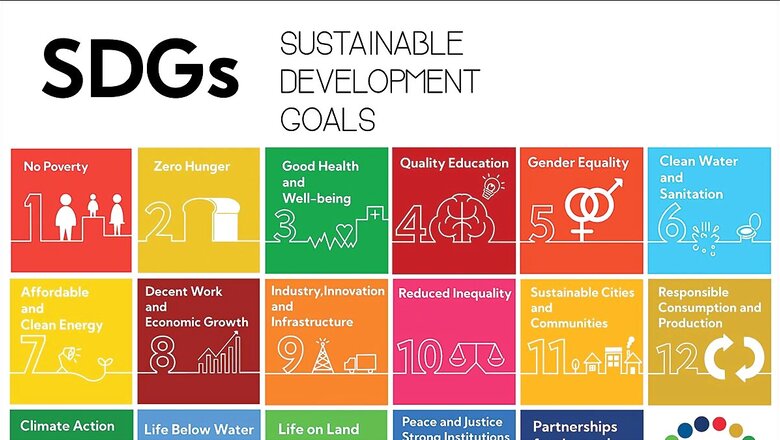
views
Monsoon is a seasonal wind that brings heavy rain to certain regions of the world, especially the sunkissed, equatorial lands of Asia and Africa. The monsoon plays an important role in the region’s ecology – from agriculture to water supply to supporting biodiversity. When the monsoon fails, or occurs later or earlier than usual, it disrupts all these cycles.
Of late, however, climate change is playing havoc with the monsoon. It feels like each year, the monsoons become more erratic and intense. Not only does this hurt our ecology, but also our built environment. When monsoons damage our infrastructure through flooding, cyclones, landslides and other events, they set in motion a cascade of problems – first, the damage and loss of life from the event itself. Next the burden of avoidable diseases like diarrhoeal disease, which are the direct result of damaged toilets.
Toilets are essential for human health and dignity, and this becomes even more evident in times of crisis. Which is why it becomes important to adapt toilets to withstand monsoon impacts and ensure safe and sustainable sanitation for all.
Understanding Climate Change and Monsoon Impacts
Monsoons are affected by climate change in various ways. For example, higher temperatures increase the evaporation of water from the oceans and land, which leads to more moisture in the air and more rainfall during the monsoon season. Also, changes in atmospheric circulation and pressure affect the timing, duration, and intensity of the monsoon winds. Some studies suggest that climate change may cause the monsoon to start earlier, last longer, and become more erratic and unpredictable.
Increased rainfall intensity and frequency during monsoons have negative effects on sanitation infrastructure. For instance, heavy rain can cause floods that submerge or wash away toilets, or landslides that bury or damage them. Moreover, excess water can seep into the ground and contaminate the groundwater sources or overflow the sewage systems and pollute the surface water bodies. This can lead to waterborne diseases, such as diarrhoea, cholera, typhoid, and hepatitis. Furthermore, waterlogged toilets can become unusable or unhygienic, forcing people to resort to unsafe alternatives. This can compromise their privacy, dignity, and safety.
Therefore, there is a need for resilient toilets that can cope with monsoon impacts and provide adequate sanitation for people living in monsoon-prone regions.
Characteristics of Monsoon-Proof Toilets
Monsoon-proof toilets are toilets that are designed and built to resist water damage and function properly during heavy rains. They have several characteristics that make them suitable for monsoon conditions. These include:
Waterproofing techniques and materials used in construction
Monsoon-proof toilets use waterproofing techniques and materials to prevent water from entering or damaging the toilet structure. For example, they use concrete or bricks coated with waterproof paint or cement to build the walls and floors of the toilet. They also use plastic or metal pipes with tight joints and valves to prevent leaks or bursts in the plumbing system.
Elevated design and flood-resistant structures
This helps to avoid submersion or inundation of the toilet during floods. They also have flood-resistant structures that can withstand strong water currents or pressure without collapsing or breaking. For example, they use reinforced concrete pillars or steel frames to support the toilet structure.
Self-cleaning and drainage mechanisms to prevent waterlogging
These mechanisms can help remove excess water from the toilet bowl or tank after each use, preventing water logging and water stagnation in the toilet. This can in turn prevent odours and infections. For example, they use flush valves that automatically release water from the tank when it reaches a certain level or sensors that detect when the bowl is full and activate a flushing mechanism.
Innovative technologies for water conservation during heavy rains
Monsoon-proof toilets use innovative technologies that help to conserve water during heavy rains when water supply may be scarce or unreliable. For example, they use rainwater harvesting systems that collect rainwater from the roof or other surfaces and store it in tanks or barrels for later use in flushing or washing. They also use low-flow faucets or shower heads that reduce the amount of water used per flush or wash.
Benefits of Monsoon-Proof Toilets
Monsoon-proof toilets have many benefits for people living in monsoon-prone regions. They can:
- Improve sanitation and hygiene by providing a clean and functional toilet.
- Reduce the risk of waterborne diseases by preventing the spread of pathogens or pollutants through water sources or sewage systems
- Enhance privacy, dignity, and safety by offering a secure and comfortable toilet that protects from harassment or violence
- Save water and energy by using less water per flush or wash and relying on renewable sources of water or power
- Promote environmental sustainability by reducing greenhouse gas emissions from fossil fuels or waste management
Championing the Cause of Monsoon-Proof Toilets
When you think of how beneficial these toilets are, and how much money they save us in public health over the long run, why don’t we already have monsoon-proof toilets everywhere? That’s the awareness gap.
Harpic, as India’s leading brand in lavatory care, is well aware of the education and awareness gap on any subjects related to toilet use, toilet hygiene and toilet infrastructure. Simply put, we just don’t talk enough about toilets!
Fortunately, that is changing. From 2014-2019, the GoI ran the world’s largest sanitation drive – the Swachh Bharat Mission, shedding light on just how important toilets are for the health and well-being of our communities. Building on that dialogue, Harpic and News18 came together 3 years ago to create Mission Swachhta aur Paani, a movement that upholds the cause of inclusive sanitation where everyone has access to clean toilets. It advocates equality for all genders, abilities, castes and classes and strongly believes that clean toilets are a shared responsibility.
Mission Swachhta aur Paani also serves as a repository of all the information you need to make a convincing argument to your local municipal body, to adopt monsoon-proof toilet designs. All that’s needed now is for you to act. Be it a simple conversation with your family about upgrading your own toilet, or adopting a better maintenance schedule for your drainpipes and septic tank, or campaigning your local MLAs and municipal officials for upgrading local public toilets – you have everything you need.
What we talk about matters. Join us here to learn about how you can add to this crucial national conversation.

















Comments
0 comment